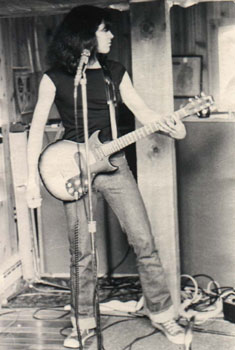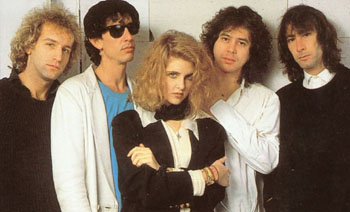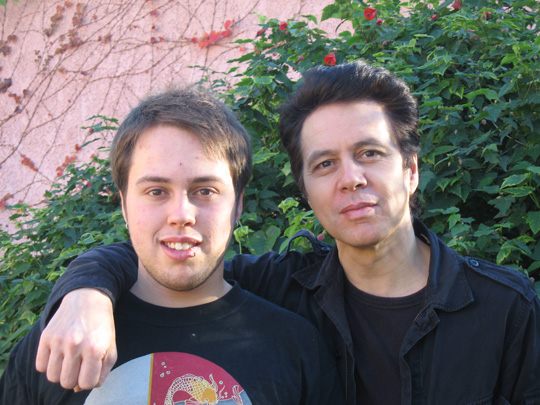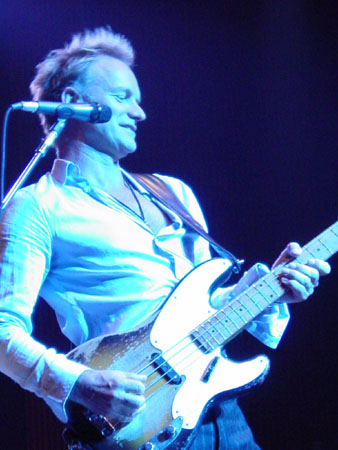 Credit: Marc D’Amour.
Credit: Marc D’Amour.
This month’s Spotlight is on Shane Fontayne. “Who is Shane Fontayne”? some of you may ask. If you don’t know who Shane is then you are about to discover an extremely talented musician who plays and lives his life with presence. For those of you who do know of Shane then you will be reminded of his lengthly, colorful career and get more of a glimpse at the guitar player part of him. Shane has crisscrossed the globe with the simplest of tools playing from his soul with tangible feel. Literally the list of artists he has provided his magical guitar style for is nearly endless including Steve Forbert, Lone Justice, Billy Burnette, John Waite, Bruce Springsteen, Paul Simon, Rod Stewart and Marc Cohn just to name a few. Along with being a very expressive, tasteful guitarist he is an exceptional singer and songwriter. His guitar playing enhances his songs and they work together as one voice. Whether it’s the airy spaciousness of “Little Naploeans” the jazzier instrumental “Seranade” or the haunting “Voodoo in the House” from the CD What Nature Intended, Shane seems to express himself through his music in a way that you can fully assimilate and take with you wherever you go. Shane is much more than a “hired gun” he is more like a “hired arsenal”.
300guitars: Hi there Shane. Please tell us about yourself. Where you were born, raised and when did you become interested in playing the guitar?
Shane Fontayne: I’m a Londoner by birth – born “within the sound of Bow bells” – Bow being a section of East London. If you’re born within the radius of the sound of the bells at the church there, you are by definition a Cockney!
I eventually grew up in the more suburban and sometimes more fashionable areas of North London, around Highgate and Hampstead. I lived around the corner from The Kinks and once ran into the Spencer Davis Group (with both Stevie and brother Muff Winwood) at the local Wimpy Bar, England’s version of McDonald’s way back when.
By age seven or eight, growing up in the early 60’s, I was already enthralled with the magic icon of the guitar, watching my brother and one of his friends learning Peggy Sue and Everyday by Buddy Holly. I picked it up literally and figuratively.
300guitars: What was your first guitar?
Shane Fontayne: First acoustic: A “Selmer” steel string. Selmer was a well-known British music store in the center of London.

First electric: A Watkins Circuit 4 – a snazzy four pickup extravaganza along the lines of the Watkins Rapier 22 (two pickup) and Rapier 33 (three pickup) models.
I got the Selmer in 1963 on my ninth birthday. The Watkins may have been a year or two later.
My first professional electric guitar was a sunburst Gibson Melody Maker.
300guitars: Who were your early influences and who do you listen to now?
Shane Fontayne: The first guitar influence, as with many others of the era, was Hank Marvin of The Shadows – a British contemporary of The Ventures – but in my opinion vastly superior. They were also Cliff Richard‘s backing band. Hank’s sound was all Strat with tremolo arm, reverb and delay. Hey! Sounds like me!
The Beatles were the hugest musical influence and all of the British 60’s bands in various ways, were all heroes of mine. Townshend with The Who. Tony Hicks with The Hollies. Jeff Beck with The Yardbirds. It was as much the sound that moved and electrified me. Then I was exposed to Chuck Berry and Bo Diddley also thanks to the British bands’ love of American rock’n’roll and r’n’b.
Now I listen to what for me is genuine and real whether that be Miles Davis, Ella Fitzgerald and Louis Armstrong or Radiohead and Bach.
300guitars: When did you start to play professionally?
Shane Fontayne: I joined a band of schoolboy heroes – Byzantium – in 1972. I had grown up around them, though I was a few years younger than some of them. They were my mentors and when I went into a studio the first time to record some of my songs, they accompanied me. I couldn’t have felt a bigger buzz and when I was asked to join the band, I was overjoyed. We toured Britain and Europe until the Fall of 1975. They had already released one album by the time I arrived and then we released another, on A&M (WB in the U.S.) and subsequently a rare and sought after self-released album (Live and Studio).

300guitars: While working with Byzantium, what guitars and amps were you using?
Shane Fontayne: Short answer! Gibson Melody Maker with a Tele pickup at the bridge position and a Fender Tremolux head with a 2 x 12 cabinet that had Celestions in it I think.


300guitars: What are your current favorite guitars that you like to use as tools? Your nuts and bolts “go to” guitars. Do you pick certain ones for different artists you are working with?
Shane Fontayne: Good question. Picking guitars for different occasions really defines my playing. The guitar that is probably closest to my DNA is my Gretsch Tennessean. It’s in the fullness of the semi-hollow bodied sound and that classic Gretsch sound with the beautiful top end. But I rarely play it live these days.

My Strat is the most flexible instrument in general – certainly a nuts and bolts guitar. I can dynamically dial in what I need quickly and easily. I recently played a couple of shows with a jazz trumpeter friend and I borrowed my son’s PRS (Paul Reed Smith) Custom 24. That’s what it has come down to, borrowing my son’s gear! It was beautiful, very classy and expressive. Maybe I should get one of my own!
300guitars: Why don’t you play the Tennessean live too often?
Shane Fontayne: The last time I consistently toured with the Tennessean was in Bruce Springsteen’s band. It has a lower output than some other guitars. I use compression, which raises the level but its resonance can be an issue in a more dynamic live situation. It is not so easy to ride the volume control on the Gretsch and it modifies the tone considerably to role off the volume.
Playing with Marc Cohn, the Strat is more practical and flexible, if I am touring with only one instrument. The Gretsch Tennessean, however, may be most closely linked to my DNA. Maybe I need to be more flexible – like a Strat!

I was in the studio recently and as always, the Tennessean was beautiful, languid and stylishly rocking!
300guitars: Are you picky about pickups for your guitars? (no pun intended….)
Shane Fontayne: No. I’m not picky about gear in general. It either works for me or it doesn’t. Various guitar techs and musicians have been very helpful in suggesting things at different times and I have often followed their advice. But as far as guitars go, it is that combination of feeling right and sounding right. It’s very subjective. I believe a good test of an electric guitar is how it sounds acoustically. You can tell a lot about what its tone and resonance will be even before you plug it in.
300guitars: What strings (brand and gauge) and picks do you prefer?
Shane Fontayne: D’Addario XL140 (.010-.052) electric strings. D’Addario EJ16 (.012-.053) acoustic strings and for years I have used Gibson GG40 (I think) heavy gauge, teardrop picks which they no longer make! If anyone knows of anything similar, please let me know. I’m recycling the old ones!
300guitars: What about your current main amps?
Shane Fontayne: Same as it ever was! Old Fender, old Ampeg. But I do love the Bogner Shiva combo which I have used a few times. Generally I have always been an open-back combo type of player. Could be time for a change….
300guitars: What type of pedals are on your pedalboard?
Shane Fontayne: MXR Dyna Comp (compressor) is the old standby. Line 6 Delay has supplanted the old Echoplex. Line 6 Modulation pedal, good for Leslie and Univibe, Ernie Ball Volume Pedal, Big Muff, Wah, Boss Tremolo, Diaz Square Face (distortion) and MXR Micro Amp.

300guitars: For live applications do you prefer being wired or wireless?
Shane Fontayne: Probably wired. I have enjoyed being wireless too. If I’m changing guitars and only using one transmitter, it just seems faster, simpler and less cumbersome to change with a regular cable. It’s more about efficiency than sonic preference. There are actually some aspects of going wireless that I can sonically prefer, like I have noticed that it drives certain effects in a different manner.
300guitars: Is your live rig different from your studio rig? Again does it depend on the artist you are working with?
Shane Fontayne: In the studio I will try and eliminate whatever isn’t needed in the moment from the chain. Sometimes I prefer to just go straight into the amp in the studio and monitor reverb and delay in the headphones or on the speakers. It depends how much control one has at one’s fingertips and the sonic environment.
I feel that guitarists often get the short end of the stick in the studio in a tracking situation. It shouldn’t be a given that an amp should be sequestered in a different room or down a hallway. Part of the beauty of the Tennessean, for instance, is the resonance between guitar and amp. The connection is key and isolation is overrated!
300guitars: What did your rig consist of when you were with Lone Justice?
Shane Fontayne: Funny, back in ‘86/’87 CD’s were still a new format. It was the third medium of product behind LP’s and cassettes. Point being, I was still very much into the Echoplex, and I still had the Dyna Comp. It was Steve Van Zandt who turned me on to the Micro Amp at that time. I was touring with the Tennessean, my ’55 Tele and a Fender Bass 6 (baritone) which I bought from John Sebastian of the Lovin’ Spoonful. My sensibility tends towards the analog. My amp was a tweed Peavey Vintage with 2 x 12 EV speakers.

300guitars: I am a huge Telecaster nut. Tell us about your ’55 Tele.
Shane Fontayne: It has a V neck that slots into the palm of my hand. Up until the time I got it, the Melody Maker was all I had known. In 1977 I played with Nick Jameson, a name many people don’t know but should. He engineered and mixed one of the most important records of my youth – Bonnie Raitt’s second album, Give It Up, a raw, beautiful, rootsy, perfectly compressed and explosive sounding album. Nick played bass on Foghat’s records and produced them as well. He is an outstanding all around musician who is now a comedian I believe! All of these things took place in Woodstock, NY.
Nick asked me to tour with him while promoting his solo record Already Free on Bearsville Records and he told me I needed to get a second guitar and that he would pay for it. That was the only time I have ever been told that! I found the Tele at We Buy Guitars on 48th Street in New York City. It cost $750 in 1977. I remember calling Nick from a pay phone outside the store and telling him what I had found and, sheepishly, how much it cost. He unhesitatingly told me to get it.
It had been routed out for a humbucker in the neck position but it came with two Tele-style pickups. The bridge pickup was probably stock. The neck pickup I soon changed for a Seymour Duncan pickup, I think.
Later, Erik Cartwright (brother of Brett – my partner in Merchants Of Venus) and also a member of Foghat, installed a Bill Lawrence pickup in the neck position with a humbucking push/pull pot as an option. When the original bridge pickup started to give out, I replaced that also with a Seymour Duncan Tele pickup.

300guitars: When you worked with Bruce Springsteen back in the early 90’s what was your rig like?
Shane Fontayne: Bruce’s crew persuaded me to go for a Bradshaw rig. Very high tech for me. In addition to the pedals I mentioned above, I also was using a TC 2290 Delay rack mount box and a rack mount Sans Amp. The Bradshaw unit stored all the presets known to man and then I had to remember what they were!
A Gretsch RocJet was an additional guitar on that tour and I had two reissue 4 x 10 tweed Bassman’s.

300guitars: How did it differ from Bruce’s?
Shane Fontayne: Vastly! Bruce liked the Sans Amp and got one. I think that was it for him – apart from a volume boost switch.

300guitars: Who are your techs or do you perform your own tech work and maintain your equipment?
Shane Fontayne: Norik Renson (Renson’s Guitar Shop, 11632 Moorpark St, Studio City, CA 91602. 818.761.4766) in Studio City, CA is who maintains my gear along with his co-worker Brett Sandberg. They are wonderful at what they do. Norik also built my current pedalboard prior to my touring with Sting in 2005.
300guitars: Do you collect guitars and amps?
Shane Fontayne: I rarely sell anything. I don’t collect per se. But I have heard so many tales of musicians regretting letting go of an instrument or amp that they wish they had. Mind you, I’m not adverse to finding something a home if it might be better served elsewhere.
300guitars: When did you first start writing songs?
Shane Fontayne: I was eleven or twelve. I took my first song called “I Was Wrong” to The Yardbirds and met them twice, once at London’s famed Marquee Club. I played Jeff Beck’s Telecaster backstage at another venue. This twelve year old child hounded Giorgio Gomelski their manager – almost into submission!
300guitars: What is the writing process like for you? What is your inspiration?
Shane Fontayne: Just pick up a guitar. Usually the first flush or thrust of the first thing I play on any given day will contain the kernel of an idea. Other tunings are an inspiration. If I play, I will write.
300guitars: Do you read music? What is your musical education or are you more a self-taught “ear player”?
Shane Fontayne: I am self-taught, other than a brief series of lessons as a child. But most importantly for me was growing up around childhood friend Robin Sylvester (currently the bassist for Ratdog – Bob Weir’s band) who was able to listen to a record once and then show me how to play it.
This included such complex things as the arpeggiated descending run in Help! or the opening chord to A Hard Day’s Night. I’ve never met anybody who has played that chord the way that Robin taught me in 1964, and which sounds right to me still.
I can read, s-l-o-w-l-y, and it is one of the things I would love to vastly improve. It is a language, as much as any language and one in which I would love to converse, in a fluent and meaningful way. It opens up a new world of understanding and communication. For instance, I love orchestration, and while it is possible to do as McCartney used to – singing ideas to George Martin who would then interpret and transcribe – or these days to try ideas on a keyboard with samples – how wonderful it must be to score with the knowledge and acumen that formal training would make accessible.
300guitars: What are some of your other interests outside of the music industry and playing guitar?
Shane Fontayne: I am an avid baseball fan, though things are not going well for my particular New York sports team right now, the New York Yankees! A spinoff of the Johnny Average Band (Woodstock – late ‘70s) chose the name New York Yanquis as a ploy to convince me to join!
Music and life are so intertwined for me in every way. I have thought of myself more as a musician whose mode of expression is through the guitar, more so than as a “guitarist”. Living well and happily are important.
My son Shane Barakan is a wonderful writer, singer and player. He and I spend a lot of time with each other. Recently we have been practicing together and it seems to drive us both.

I love to travel. It’s an ultimate form of freedom.
300guitars: What was the last book you read? And some of your favorites.
Shane Fontayne: I usually have a number of books that I am reading at the same time. Recently those include: The Divine Romance by Paramahansa Yogananda, New Seeds Of Contemplation by Thomas Merton and The Dynamic Laws of Prayer by Catherine Ponder.
300guitars: How much of your time is spent on the road, in the studio and being home?
Shane Fontayne: It varies so much from year to year. This past year has been a road year, having toured a lot with Marc Cohn with whom I have worked for ten years now, in support of his album “Join the Parade”. When I am home I enjoy being at home. I have a studio in the house, but doesn’t everybody these days?! So I can be at home and in the studio too.
300guitars: How do you keep healthy and maintain a sense of home on the road?
Shane Fontayne: I’m an early riser and because the morning is such a valuable time for me, I try to get to bed as early as I can. And I work with people who enjoy eating well and healthfully! They laugh a lot too.
300guitars: What are some of the most memorable highlights of your career (and/or life in general)?
Shane Fontayne: One would be that first intro to the music biz with The Yardbirds, also my time in Byzantium which I have recently realized was one of the most precious times for me, meeting Mick Ronson when I first came to America and going with him to Woodstock where I met various icons and heroes (Rick Danko, Paul Butterfield, John Sebastian, Nick Jameson – who recorded and mixed Bonnie Raitt’s “Give It Up” album – a hugely influential record in my development, and my dear friend Randy Vanwarmer), meeting Billy Burnette through my work with Steve Forbert who introduced me around town in L.A. in the eighties which led to Lone Justice which led to The Boss and what an amazing experience it was to play with Bruce.
Sitting at Paul Simon’s feet while he played me a song I was going to record with him, performing on Copacabana Beach on New Year’s Eve with Rod Stewart in front of the largest outdoor crowd ever (Guinness Book Record), touring all of France a couple of times over with Johnny Hallyday, my relationship with Marc Cohn that has endured longer than any other, being asked by Sting to tour as part of a four-piece band with him, being in the studio with Dr. Dre.
All these things and being a father immediately come to mind.
300guitars: Working with Sting must have been a great experience. What was it like to work with him?
Shane Fontayne: It was wonderful and one of the most challenging things I have ever done. He is a driven man who seems to challenge himself at every turn. It is hard to imagine that he doesn’t audition musicians but goes with his gut and commits to that decision.
I was fortunate to be drafted by him and Dominic Miller, Sting’s longstanding guitarist, when he wanted to try a four-piece, two guitar, bass and drums lineup. Keyboards are so prominent in his solo work and by going with this lineup it meant there would be a huge orientation change for him.
But he gave himself over to the process and chose the material that ultimately worked best for him. It eventually leaned more and more towards The Police material and presumably provided a natural segue for their tour over the last couple of years. Most of The Police material I played on my Tele in a DADGAD tuning. That’s how a lot of those songs worked best for me.
I particularly treasure the time we spent rehearsing at his beautiful home in Tuscany, where we would eat, drink, be merry, walk, chat and do yoga together. He was a most gracious, relaxed and friendly host and I feel quite humbled to have spent a few evenings onstage performing in his band.
 Credit: Sophia Dilberakis
Credit: Sophia Dilberakis
300guitars: Who are you currently working with?
Shane Fontayne: I have recently played with old friend Chris Botti and his brilliant band. I am still on tour with Marc Cohn who is always an inspiration. I even played some shows this Summer with another old friend, John Waite.
300guitars: Do you have any plans for more solo projects of your own music in the near future?
Shane Fontayne: There are various projects on my mind and at my fingertips. I would love to make another CD of original songs, also a solo guitar record, and I could see writing a book and also using my spoken voice in some capacity. I would love to try some speaking engagements, sharing the experiences of my career and talking about the ups and downs of being in bands in different capacities and what it takes to navigate a career in music.
300guitars: What do you see in the future for Shane Fontayne?
Shane Fontayne: To be in the present!
300guitars: Thank you very much Shane for taking the time for this Spotlight interview. You are a great musician and I wish you all the best in the future!
Shane Fontayne: Thank you for asking.
Visit Shane Fontayne’s Website here.
Essential Listening: What Nature Intended, Lone Justice-Shelter.
Essential Viewing: Bruce Springsteen In Concert – MTV un-Plugged.